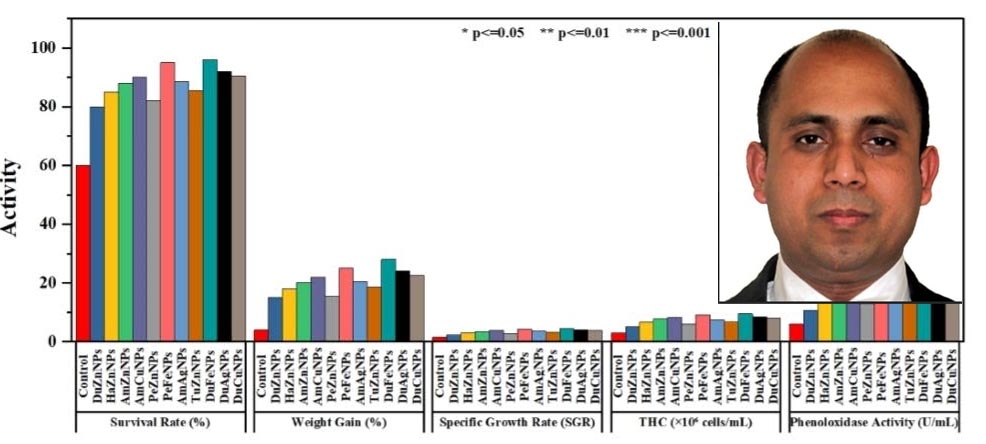Bangladesh’s Indigenous Nanoparticle Revolution: Medicinal Plants Power a Shrimp Farming Breakthrough
Published: 01:54 PM, 17 November 2025 Last Update: 02:05 PM, 17 November 2025
Bangladesh’s Indigenous Nanoparticle Revolution: Medicinal Plants Power a Shrimp Farming Breakthrough

Sheikh Shadi Bhuiyan, JUST Correspondent:
Bangladeshi researchers have taken a significant step forward in sustainable aquaculture by converting native medicinal plants into advanced nanoparticles for shrimp farming. This groundbreaking work, published in Microbial Pathogenesis 210 (2026) 108144 (https://doi.org/10.1016/j.micpath.2025.108144 ), marks a transformative leap in how disease management and productivity are approached in one of the country’s cornerstone sectors.
Led by Professor Dr. Md. Mer Mosharraf Hossain at Jashore University of Science and Technology (JUST), the research team engineered and characterized multi-metallic nanoparticles from Tulsi, Amloki, Dumur, Pepe, and Haritaki. Their primary goal was to harness these plant-extract-based particles as both immunostimulants and disease controllers in brackishwater shrimp hatcheries and grow-out systems facing persistent threats from Vibrio infections. Through in-depth biological expertise and use of regional biodiversity, the work speaks directly to the national priorities of food security, export competitiveness, and environmental stewardship.
The challenge in Bangladeshi shrimp farming is immense. This sector anchors rural income in the southwest, supporting millions of jobs and contributing to the country’s GDP and foreign exchange. Yet shrimp are uniquely susceptible to disease, lacking the adaptive immune memory that helps vertebrates resist recurring bacterial threats. Vaccines provide only fleeting protection against diseases like AHPND, leaving farmers reliant on chemicals and antibiotics that can lose effectiveness over time and raise concerns about residues in exported seafood.
The study’s breakthrough comes in its immune-nanoparticle–enriched feed formulations, allowing every shrimp meal to fortify natural immune defenses and directly disrupt harmful pathogens. Rigorous 42-day feeding trials showed Dumur-derived zinc nanoparticles yielding a 96% survival rate, significant increases in growth, immune markers such as lysozyme and phenoloxidase, upregulated immune-related genes, and greatly reduced post-challenge mortality compared to standard feed. Importantly, these benefits came without observed toxicity at practical dosages and with nanoparticle residues well beneath established safety limits.
Farmers, processors, and the wider aquaculture supply chain are directly poised to benefit. Because the synthesis relies on common native plants and simple, low-cost methods, the technology is accessible and scalable, from small family farms to industrial operations. The switch from imported drugs and chemicals to plant-based immuno-nanoparticles can trim input costs, meet stringent international safety standards, and help Bangladesh maintain its competitive advantage in global shrimp exports. Rural communities will see immediate gains in income, financial stability, and resilience against disease-driven shocks, while processors and exporters will enjoy a more stable supply of healthy, quality shrimp.
The scientific impact is equally profound. Most antibiotics and imported nanoparticle products only target pathogens directly, often at the cost of disrupting beneficial microflora or triggering resistance. By contrast, these plant-based nanoparticles have a dual function: protecting shrimp with both antimicrobial and immunomodulatory effects and stimulating broad innate immunity. This leap in crustacean immunotherapy opens new avenues for sustainable, culturally-rooted disease management technologies in tropical aquaculture, aligning with global targets for biosecurity and food safety.
Technical validation used SEM, EDX, FTIR, GC-MS, and XRD analyses to confirm the presence of Ag, Zn, Cu, and Fe, and the biological safety of the nanoparticles. The application in large-scale trials provided compelling and statistically sound improvements in shrimp health and resilience, underscoring the practical readiness of the solution for real-world adoption.
Beyond the immediate farm gate, the implications are global. The transferability of this green nanotechnology using local biodiversity and scalable synthesis means the model can benefit aquaculture in Asia, Latin America, and Africa, wherever disease-prone seafood industries require cost-effective, and sustainable management tools. Organizations like the FAO, World Bank, global aquafeed leaders, and food safety regulators can leverage the method for international best practices in sustainable seafood production and health management.
Moreover, the research creates momentum for future directions in aquaculture science: further optimization of nanoparticle dosing, field-scale trials, integration with smart aquaculture platforms like sensor-based water quality monitoring, and expansion to other aquatic species. The molecular insights open avenues for advanced studies in crustacean immunology, nanotoxicology, and host-microbe interactions, promising continued innovation and broader impacts for aquatic food security.
In essence, Professor Hossain’s team has delivered not just a solution but a roadmap, merging traditional botanical knowledge with new frontiers in nanotechnology. The plant-derived immuno-nanoparticles address an urgent national need for better shrimp health and sustainable farming, while also setting a standard for global aquaculture innovation. As climate change and regulatory demands reshape food production, Bangladesh’s scientists are showing that indigenous resources and advanced research can forge the way to healthier, safer, and more ecologically sound aquatic systems worldwide.



